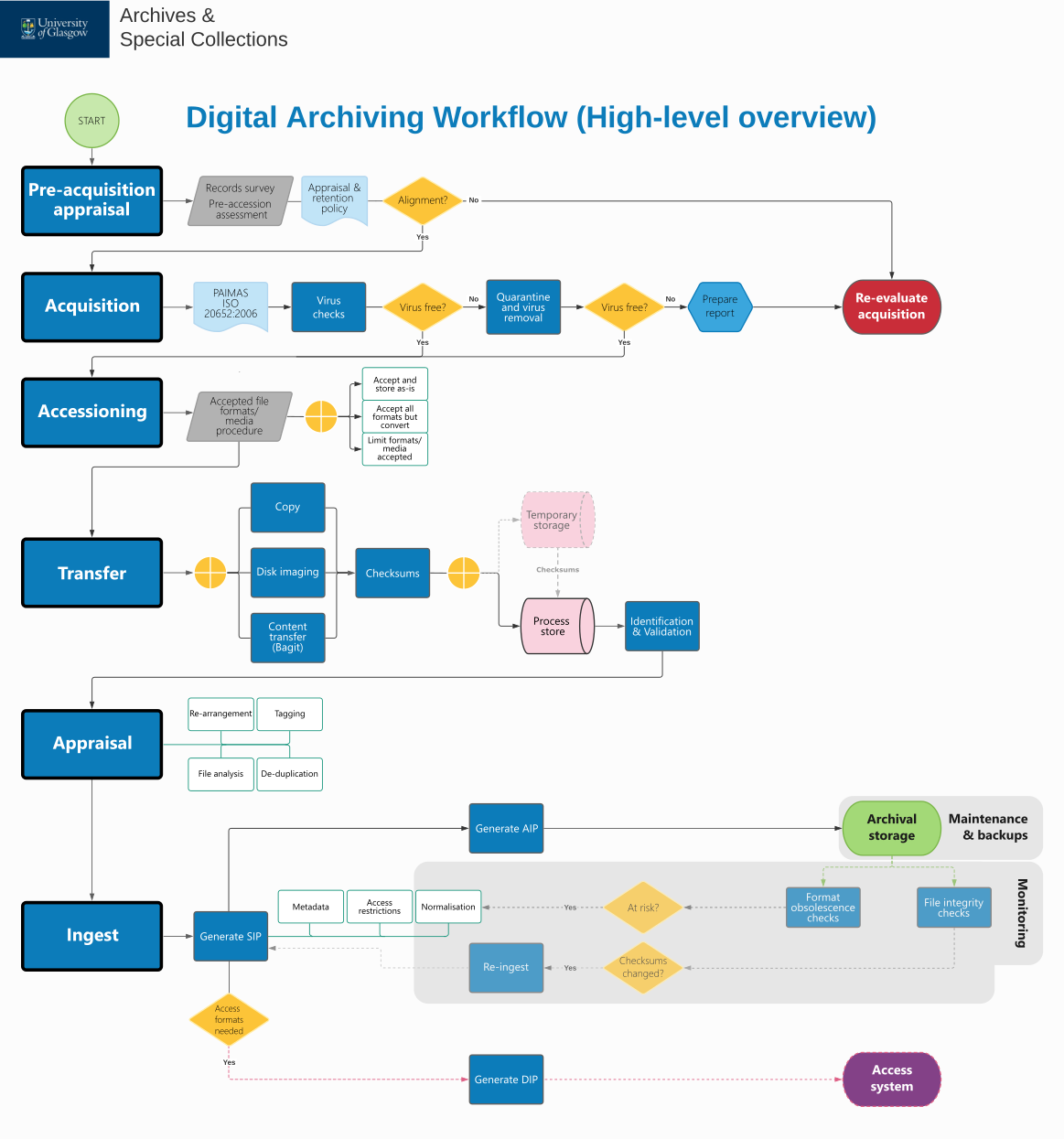Difference between revisions of "Workflow:Digital archiving workflow (high-level)"
Jump to navigation
Jump to search
(Created page with "{{Infobox COW |status=Experimental |tools=Archivematica, Bagger, BitCurator, DROID (Digital Record Object Identification), TeraCopy, PAIMAS |input=Request for deposit of digit...") |
|||
| Line 49: | Line 49: | ||
# In all cases, generate checksums to verify data integrity during transmission and/or storage: | # In all cases, generate checksums to verify data integrity during transmission and/or storage: | ||
#* For digital acquisitions <i>in situ</i>, it might be appropriate to first store files in a temporary location for virus and/or integrity checks, before transferring to process store. Not applicable to all scenarios. | #* For digital acquisitions <i>in situ</i>, it might be appropriate to first store files in a temporary location for virus and/or integrity checks, before transferring to process store. Not applicable to all scenarios. | ||
| − | #* Transfer digital materials to Process store (e.g. network drive). | + | #* Transfer digital materials to Process store (e.g. network drive). |
| − | + | # Use tools to identify file types and validate file formats (e.g. DROID, JHOVE), then proceed to Appraisal | |
| − | + | ; APPRAISAL | |
| + | : Processes for selecting digital materials from an acquisition, which are deemed as appropriate for lo-term preservation and archiving. | ||
==Purpose, Context and Content== | ==Purpose, Context and Content== | ||
Revision as of 16:28, 23 November 2021
Workflow Description
- START
- A request for deposit of digital materials (by transfer, donation, or purchase) is submitted to the University Archives.
- PRE-ACQUISITION APPRAISAL
- Processes for evaluating whether a deposit request will be accepted by the University Archives.
- Prepare a records survey and/or pre-accession assessment of the proposed deposit.
- Evaluate the results of the records survey against the Appraisal & Retention policy, which:
- addresses issues pertaining to selection and long-term retention of digital objects
- extends the Archives & Special Collections collection development policy
- Ensures that retention decisions are balanced between value and capacity to preserve for the long-term; and
- provides clarity to avoid assumptions over digital storage costs and availability.
- Decide whether the requested deposit aligns with policy:
- If not, re-evaluate acquisition and/or reject deposit.
- If yes, proceed to Acquisition.
- ACQUISITION
- Processes for acquiring digital materials by transfer, donation, or purchase.
- Follow methodology in the Space data and information transfer systems — Producer-archive interface — Methodology abstract standard (PAIMAS) ISO 20652:2006 standard. The standard "identifies, defines and provides structure to the relationships and interactions between an information producer and an archive. It defines the methodology for the structure of actions that are required from the initial time of contact between the producer and the archive until the objects of information are received and validated by the archive." (ISO). For more information, see Acquisition and appraisal, Digital Preservation Handbook (DPC).
- Check digital materials for viruses. See Select and transfer section 1.3 for a reasonable process. Depending on the results of virus checks:
- if virus is found, quarantine and attempt removal; and/or request clean versions from source. If all these fail, prepare a report documenting actions and re-evaluate acquisition.
- if virus-free, proceed to Accessioning.
- ACCESSIONING
- Process of formally accepting material into the University Archives, which enables intellectual control over the digital materials.
- Follow standard accessioning practices as per non-digital acquisitions.
- Follow the Accepted file formats/media procedure, which:
- Specifies decisions on file formats and/or storage media that the University Archives will accept.
- Aligns with preservation planning decisions for format normalisation; and capability to access storage media (esp. legacy media, e.g. floppy or zip disks).
- For a summary table of options, see the Acquisition workflow section in Acquisition and appraisal, Digital Preservation Handbook (DPC).
- Proceed to Transfer.
- TRANSFER
- Processes for transferring digital materials to the University Archives.
- Choose a method for transferring files:
- Copy files from source media. OR
- Create a disk image from source storage media. OR
- Request that digital materials are submitted as a BagIt container.
- In all cases, generate checksums to verify data integrity during transmission and/or storage:
- For digital acquisitions in situ, it might be appropriate to first store files in a temporary location for virus and/or integrity checks, before transferring to process store. Not applicable to all scenarios.
- Transfer digital materials to Process store (e.g. network drive).
- Use tools to identify file types and validate file formats (e.g. DROID, JHOVE), then proceed to Appraisal
- APPRAISAL
- Processes for selecting digital materials from an acquisition, which are deemed as appropriate for lo-term preservation and archiving.
Purpose, Context and Content
The workflow aims to formalise digital archiving activities, and incorporate digital preservation processing requirements. It has been designed as an experimental tool for testing production-level digital preservation processing at the University of Glasgow Archives. Production-level here describes in vivo test conditions in terms of:
- data volume per transfer and ingest
- file format types and variability
- acquisition and accessioning procedures
- currently available technical infrastructure, including computing, local/shared storage and network speed/capacity on campus.
Evaluation/Review
The workflow has been successful in guiding tests of the University Archives' current digital preservation capability; and evaluating the suitability of our current setup for production-level digital preservation. Currently in version 0.3, it is continuously amended until reaching version 1.0 after which it will be reviewed on an annual basis.
Further Information
- Digital Preservation policy, University of Glasgow
- Collections development policy, Archives & Special Collections, University of Glasgow
- Digital Preservation Handbook, DPC
- Digital preservation workflows, The National Archives
